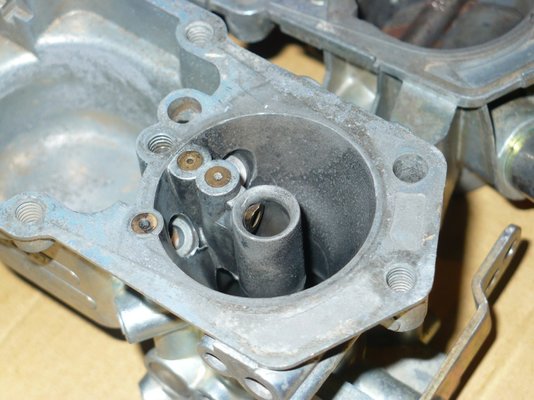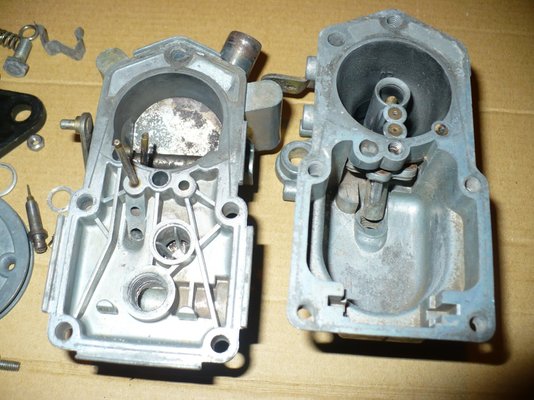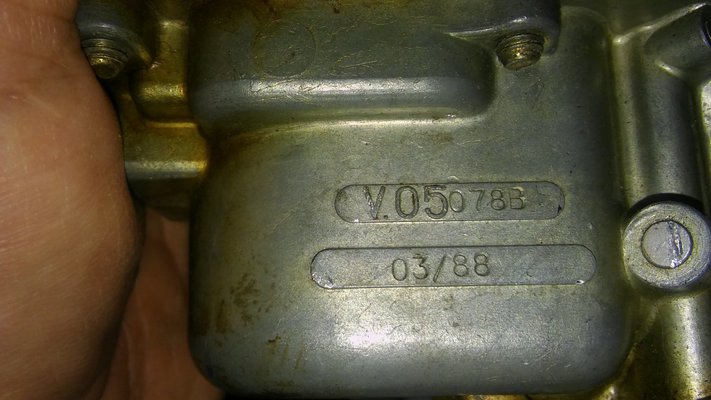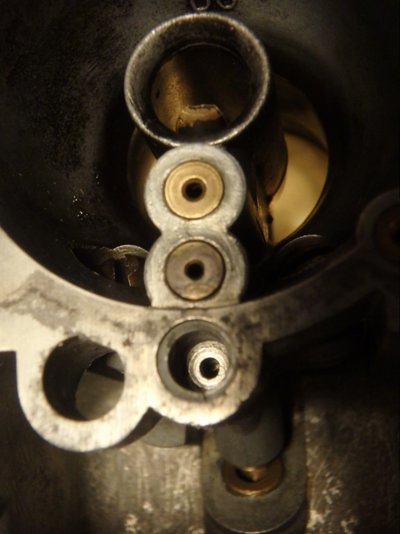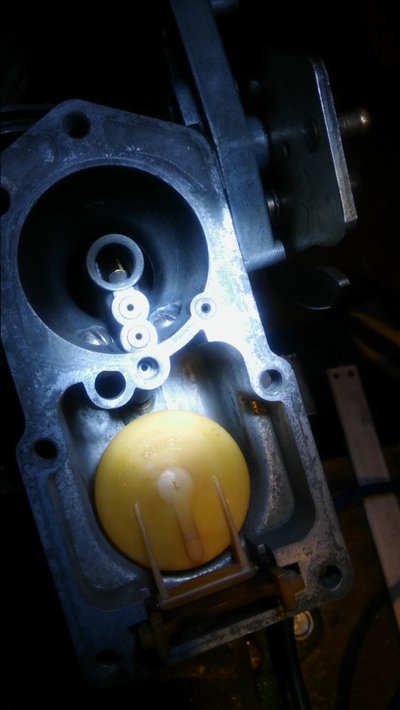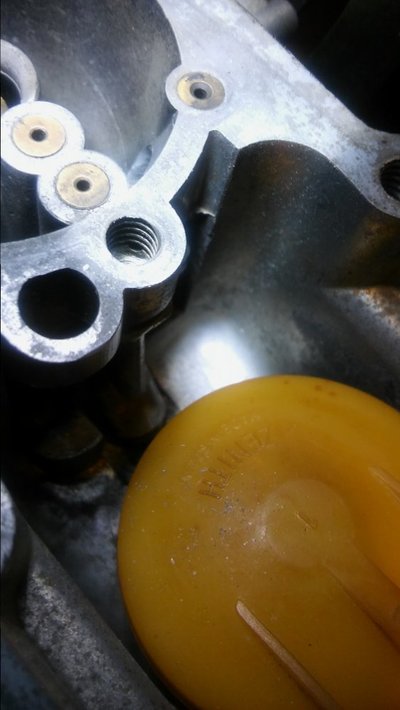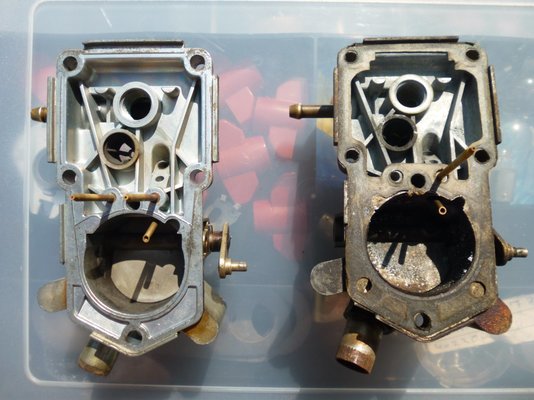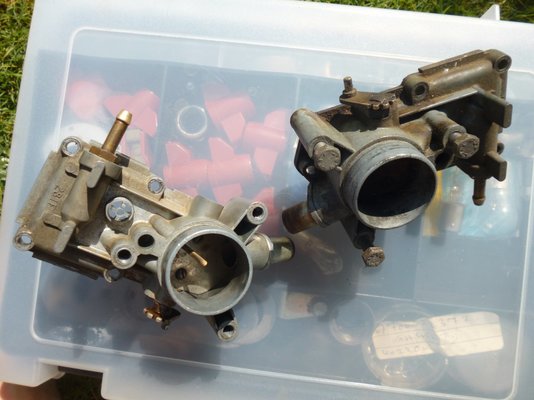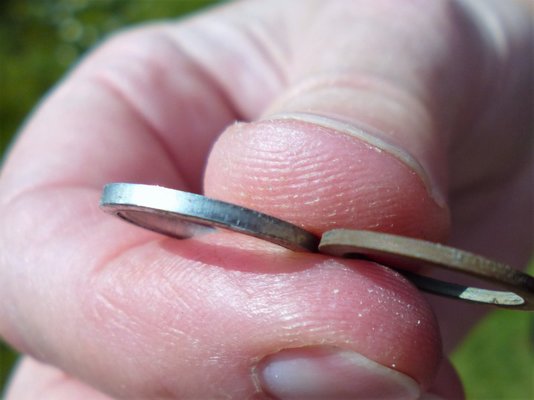You are using an out of date browser. It may not display this or other websites correctly.
You should upgrade or use an alternative browser.
You should upgrade or use an alternative browser.
Zenith 28IF problem solving
- Thread starter mojobaby
- Start date
mojobaby
Enthusiast
- Messages
- 1,320
And very relevant to this thread, is Andrew4Renaults comment which I've copied from Petak's page:
The way I would attempt to sort this would be to start with the electrical side of things; confirm the points are correctly set to the right gap and that they are correctly timed. A good strobe lamp can help, as this will give a dwell angle, which is more accurate than using feeler guages to set the point gap. Then check the spark plug electrode gap & confirm the plugs are clean and not oiled up-clean or replace if necessary. Take a look at the H.T. leads and assess their condition; if they're old, brittle or show signs of rubbing change or replace. Don't forget the coil lead, too!
Now the carburettor. Check the choke cable goes fully home when the control on the dashboard is pushed fully in. I adjust these so that the control is slightly "proud" and then you know the flap in the carb is FULLY home when it's pushed in. If the action seems sticky or stiff oil the cable linkage by dribbling a little 3 in 1 oil down inside the cable and do the same to the accelerator linkage if it feels similarly stiff or sticky.
Check the air filter for condition and clean out the housing of leaves etc. Change the air filter if necessary. make sure the intake is set for winter or summer, as appropriate. While looking into the top of the carb give the choke cable a few "pushes and pulls" and ensure that the butterfly isn't sticking in the throat of the carb.
Check the oil level and assuming all's well, switch on & allow the motor to reach normal operating temperature. Once it has, and the choke is pushed fully in (so it's off) WITH THE CAR IN NEUTRAL use the idle screw to raise the tick-over speed slightly. (If you're not sure which screw it is, it's the one that moves the cam that attaches to the accelerator cable.) Now, with the tick-over running a liitle higher then it normally would screw the mixture screw fully into the carb, but do it gently and do not force anything! The car will start to sound "lumpy" and as you begin to unscrew the mixture the tick-over will rise (usually 1.5 to 2 turns will be about right) and the car will sound "happier." Now reduce the tick-over using the idle screw and rev the car a few times. It should rev up without any hesitancy or "gasping" for air. If it sounds OK take the car for a run & see how it feels on the road.
These adjustments are not an EXACT science with cars of the age of ours, and settings may vary from what I've suggested. All adjustments to the mixture & tick-over are done when the engine is at idle, though.
Thank you Andrew. great tips!
The way I would attempt to sort this would be to start with the electrical side of things; confirm the points are correctly set to the right gap and that they are correctly timed. A good strobe lamp can help, as this will give a dwell angle, which is more accurate than using feeler guages to set the point gap. Then check the spark plug electrode gap & confirm the plugs are clean and not oiled up-clean or replace if necessary. Take a look at the H.T. leads and assess their condition; if they're old, brittle or show signs of rubbing change or replace. Don't forget the coil lead, too!
Now the carburettor. Check the choke cable goes fully home when the control on the dashboard is pushed fully in. I adjust these so that the control is slightly "proud" and then you know the flap in the carb is FULLY home when it's pushed in. If the action seems sticky or stiff oil the cable linkage by dribbling a little 3 in 1 oil down inside the cable and do the same to the accelerator linkage if it feels similarly stiff or sticky.
Check the air filter for condition and clean out the housing of leaves etc. Change the air filter if necessary. make sure the intake is set for winter or summer, as appropriate. While looking into the top of the carb give the choke cable a few "pushes and pulls" and ensure that the butterfly isn't sticking in the throat of the carb.
Check the oil level and assuming all's well, switch on & allow the motor to reach normal operating temperature. Once it has, and the choke is pushed fully in (so it's off) WITH THE CAR IN NEUTRAL use the idle screw to raise the tick-over speed slightly. (If you're not sure which screw it is, it's the one that moves the cam that attaches to the accelerator cable.) Now, with the tick-over running a liitle higher then it normally would screw the mixture screw fully into the carb, but do it gently and do not force anything! The car will start to sound "lumpy" and as you begin to unscrew the mixture the tick-over will rise (usually 1.5 to 2 turns will be about right) and the car will sound "happier." Now reduce the tick-over using the idle screw and rev the car a few times. It should rev up without any hesitancy or "gasping" for air. If it sounds OK take the car for a run & see how it feels on the road.
These adjustments are not an EXACT science with cars of the age of ours, and settings may vary from what I've suggested. All adjustments to the mixture & tick-over are done when the engine is at idle, though.
Thank you Andrew. great tips!
mojobaby
Enthusiast
- Messages
- 1,320
Also from Petak's page are tips and advice from Harbourseal on setting up the mixture/volume screw for correct idling.
Thanks Harbourseal,
According to all my workshop manuals adjusting the mixture is as follows.
-Warm up the engine (go for a 10 minute drive that should suffice)
-Shut down the engine and screw the mixture screw all the way in and then 3 whole turns out. (that is the basis for adjusting)
-Turn the engine back on and set the tick over at 1100 RPM (with the tick over screw)
-Now turn the mixture screw and let the engine make max RPM (until the RPM does not go any higher) Don't worry you won't break the engine because you are not working the throttle.
-Turn the RPM back to 1100 RPM with the tick over screw
-Repeat the the mixture screw to max RPM.
-Turn the RPM back to 1100 RPM with the tick over screw
-Repeat the steps until nothing happens anymore when you turn the mixture screw.
-Turn the tick over back to round 750 RPM.
Before you do any of the above make sure all the electric components are working fine and all your valve clearances are ok as Andrew says.
The above proces should give you a CO of 2-3%
I got mine back to 1,5%
This way of tuning works for both Zenith and Solex carburetors.
Best way is put your car on a 4 gas test bank and make your adjustments on that bank. But since most of us don't have one we have to do it the manual way
Thanks Harbourseal,
According to all my workshop manuals adjusting the mixture is as follows.
-Warm up the engine (go for a 10 minute drive that should suffice)
-Shut down the engine and screw the mixture screw all the way in and then 3 whole turns out. (that is the basis for adjusting)
-Turn the engine back on and set the tick over at 1100 RPM (with the tick over screw)
-Now turn the mixture screw and let the engine make max RPM (until the RPM does not go any higher) Don't worry you won't break the engine because you are not working the throttle.
-Turn the RPM back to 1100 RPM with the tick over screw
-Repeat the the mixture screw to max RPM.
-Turn the RPM back to 1100 RPM with the tick over screw
-Repeat the steps until nothing happens anymore when you turn the mixture screw.
-Turn the tick over back to round 750 RPM.
Before you do any of the above make sure all the electric components are working fine and all your valve clearances are ok as Andrew says.
The above proces should give you a CO of 2-3%
I got mine back to 1,5%
This way of tuning works for both Zenith and Solex carburetors.
Best way is put your car on a 4 gas test bank and make your adjustments on that bank. But since most of us don't have one we have to do it the manual way
mojobaby
Enthusiast
- Messages
- 1,320
Thanks for this extensive walk through! Interesting to read and very helpful.
Are you also planning to do a similar topic about an Zenith 32IF7?
Thanks Jurjenz, I've never even seen one but I've read that they have an internal accelerator pump and people on the forum speak highly of them
I know that you have one which looked like new after you cleaned it up with your soda blaster
Paul Narramore
pre-moderated
- Messages
- 840
- Location
- Aylesford, Kent
Hmm, Peering into the engine compartment today at the Zenith 28 IF carb and noticed that the operating rod was hanging down loose and was unattached. I don't know how long it had been like that but re reattached it, started the engine but nothing seems any different. I presume, and please correct me if I'm wrong, that this affects the operation of the choke? Anyway she seems no different.
I also replaced the radiator temp sensor with a new one, ran the engine for about fifteen minutes, but failed to get the fan to come on. I know the fan works as I tested it the other day. As it was only 8C outside today I probably needed to take the car for a spin down the motorway and back to get it hot enough.
I also replaced the radiator temp sensor with a new one, ran the engine for about fifteen minutes, but failed to get the fan to come on. I know the fan works as I tested it the other day. As it was only 8C outside today I probably needed to take the car for a spin down the motorway and back to get it hot enough.
Melissa
Enthusiast
- Messages
- 216
- Location
- France The Lot
The carb I had on my old Saab V4 was a terrible FOMOCO thing with auto choke..which either stuck on or stuck off..so I bought a new Webber 34ICT..which worked brilliantly. Is there a carb from another vehicle that fits the old Renaults anyone know? I'm keen to get my carb working well...but might have to face the fact that a 40 year old carb might need replacing!
mojobaby
Enthusiast
- Messages
- 1,320
Yes Paul, you're correct, the rod has everything to do with the operation of the choke
When you pull out your choke control, 2 things happen simultaneously the choke flap closes at he top of the carb and the throttle butterfly at the base of the carb opens up to let fuel pass by.
The rod is the mechanism that opens the throttle butterfly.
If the rod is not connected, the only thing that happens is that the choke plate closes, but the throttle butterfly will remain closed and fuel to your engine will not pass by efficiently.
Unless of course, the position of the rod has been set up to keep the throttle butterfly open by 0,6mm to 0,80mm at all times, as I described.
One way of opening the throttle butterfly if your rod is not connected is to use your accelerator pedal. It will have the same effect. That's probably why you didn't notice any difference when you started her up.
When you pull out your choke control, 2 things happen simultaneously the choke flap closes at he top of the carb and the throttle butterfly at the base of the carb opens up to let fuel pass by.
The rod is the mechanism that opens the throttle butterfly.
If the rod is not connected, the only thing that happens is that the choke plate closes, but the throttle butterfly will remain closed and fuel to your engine will not pass by efficiently.
Unless of course, the position of the rod has been set up to keep the throttle butterfly open by 0,6mm to 0,80mm at all times, as I described.
One way of opening the throttle butterfly if your rod is not connected is to use your accelerator pedal. It will have the same effect. That's probably why you didn't notice any difference when you started her up.
mojobaby
Enthusiast
- Messages
- 1,320
Many thanks Petak, 
one small further alteration that I did today.
I found that the engine wasn't running smooth enough. I could feel a little vibration still.
Also, when I went up a long hill in 4th gear, there was a little bit of misfiring. On a flat surface it was fine.
I adjusted the rod on the carb front very slightly, 1,50mm upwards while it was idling. Immediately my revs went up.
I then reduced my idle speed by unscrewing the throttle stop screw/tickover screw.
The difference in the engine was much better, much smoother.
I think even if we set it by the book, a little further adjustment is needed, especially on older carbs.
Hopefully, members will add their tips and advice here on how they make adjustments.

one small further alteration that I did today.
I found that the engine wasn't running smooth enough. I could feel a little vibration still.
Also, when I went up a long hill in 4th gear, there was a little bit of misfiring. On a flat surface it was fine.
I adjusted the rod on the carb front very slightly, 1,50mm upwards while it was idling. Immediately my revs went up.
I then reduced my idle speed by unscrewing the throttle stop screw/tickover screw.
The difference in the engine was much better, much smoother.
I think even if we set it by the book, a little further adjustment is needed, especially on older carbs.
Hopefully, members will add their tips and advice here on how they make adjustments.
mojobaby
Enthusiast
- Messages
- 1,320
Hello, if someone has a spare Zenith 28IF lying around, could they please take out the idle jet as shown in the below photo and tell me how many holes there are at the bottom.
I know there are 2 small holes on the sides, I just need to know if the bottom is supposed to have a hole as well. Or is mine just blocked?
Many thanks!!
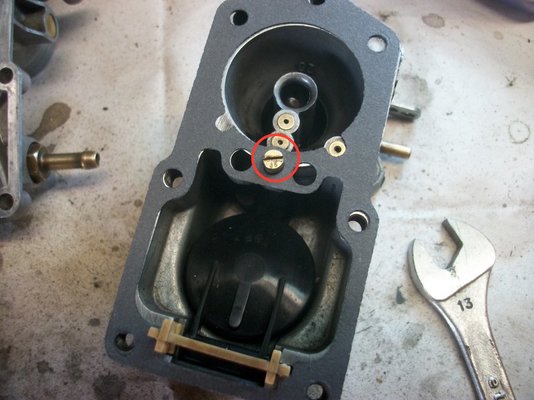
OK, guess its weekend so no replies
There is indeed a hole at the bottom. It didn't clear with carb spray so I poked a very fine wire through and cleared the hole.
The symptoms of this hole being blocked was that the car would only idle with the choke pulled out. As soon as I pushed the choke back in, the engine cut out.
At first I thought I was pulling in air from somewhere, so I tightened everything and replaced the gaskets beneath the carb and reset timing, but that didn't help.
Running perfectly again
I know there are 2 small holes on the sides, I just need to know if the bottom is supposed to have a hole as well. Or is mine just blocked?
Many thanks!!

OK, guess its weekend so no replies

There is indeed a hole at the bottom. It didn't clear with carb spray so I poked a very fine wire through and cleared the hole.
The symptoms of this hole being blocked was that the car would only idle with the choke pulled out. As soon as I pushed the choke back in, the engine cut out.
At first I thought I was pulling in air from somewhere, so I tightened everything and replaced the gaskets beneath the carb and reset timing, but that didn't help.
Running perfectly again

Last edited:
mojobaby
Enthusiast
- Messages
- 1,320
Thanks Petak, the photos are perfect. I discovered that the jet that fits into that bottom hole was blocked.
The little hole that is on the side is difficult to find, but can see it clearly in your photo.
Very strange because I remember cleaning it only 3-4 weeks ago.
The little hole that is on the side is difficult to find, but can see it clearly in your photo.
Very strange because I remember cleaning it only 3-4 weeks ago.
harbourseal
Renault R4 Lunatic
- Messages
- 1,049
- Location
- Breda The Netherlands
Hi everybody,
I made a small video on how to adjust the mixture on your carburetor. My own carburetor is a Solex SEIA 32mm. But adjusting the mixture is the same for both the Zenith 28IF and the Solex.
At the end of the video you can also see how far forward my timing is. It is just not pinking under load.
I made a small video on how to adjust the mixture on your carburetor. My own carburetor is a Solex SEIA 32mm. But adjusting the mixture is the same for both the Zenith 28IF and the Solex.
At the end of the video you can also see how far forward my timing is. It is just not pinking under load.
mojobaby
Enthusiast
- Messages
- 1,320
A well explained video, Harbourseal!
It seems that all the adjustments are done at high revs, between 1000 and 1200 and then when there is no further change you turn the throttle screw down to 700.
Even with no meter you can still tell the difference in the revs.
It seems that all the adjustments are done at high revs, between 1000 and 1200 and then when there is no further change you turn the throttle screw down to 700.
Even with no meter you can still tell the difference in the revs.
Andy McGhee
Enthusiast
- Messages
- 1,950
- Location
- Cheltenham
harbourseal
Renault R4 Lunatic
- Messages
- 1,049
- Location
- Breda The Netherlands
It seems that all the adjustments are done at high revs, between 1000 and 1200 and then when there is no further change you turn the throttle screw down to 700.
Even with no meter you can still tell the difference in the revs.
you are absolutely right Mojobaby
MarioZg
Enthusiast
- Messages
- 146
- Location
- Zagreb, Croatia
Hello! Sorry for bringing up old topic, but I have problem with my Zenith 28 IF and I don`t know what to do to solve it. First of all, carburator was cleaned, all gaskets are new, timing is set, all parts that have some role in igniton and driving are new, so I don`t have anything to replace anymore.
Problem is next- I found out that car is a little bit too slow (slower acceleration, lower max speed etc.) because I had a few R4 GTLs before it so I know how this car can drive. But car was running perfectly smooth, acceleration was a bit slow but linear, idle was constant.
Then I tried to set the mixture. I screw mixture to the end, and then unscrewd it for a turn and a half. Then I raised the rpm because engine was shaking. I could reach calm idle at about 1400 rpm which is way too high and if I set it lower the engine was shaking and turning off at breaking and releasing throttle. Then I unscrewd mixture for half of turn and then I reach calm idle at little lower (still way too high) rpm and then car was a little bit agile (prompt, faster, I`m not sure which is the right verb) but was still turning off while breaking and releasing throttle. I continued to do the same thing (unscrewing mixture, and lowering the idle) but only point where I could reach low idle (700-800 rpm) and perfectly calm engine is on 6th turn (6x360 degrees) mixture screw to the left which is, in my opinion way too rich mixture. On that setting car was like before- low idle, perfectly smooth and calm engine but slower.
I read everywhere that mixture screw has to be unscrewd between 1,5 and 3 turns for optimal mixture which is significantly less than in my case. I don`t understand what is going on here. My fuel consuption is relatively good (about 7 liters in town- around 40.3 mpg), car starts great, everything seems to be ok, but I realize the car is not agile as it should be on this setting.
Sorry for long post, I hope that somebody can help. Thank you very much!
Problem is next- I found out that car is a little bit too slow (slower acceleration, lower max speed etc.) because I had a few R4 GTLs before it so I know how this car can drive. But car was running perfectly smooth, acceleration was a bit slow but linear, idle was constant.
Then I tried to set the mixture. I screw mixture to the end, and then unscrewd it for a turn and a half. Then I raised the rpm because engine was shaking. I could reach calm idle at about 1400 rpm which is way too high and if I set it lower the engine was shaking and turning off at breaking and releasing throttle. Then I unscrewd mixture for half of turn and then I reach calm idle at little lower (still way too high) rpm and then car was a little bit agile (prompt, faster, I`m not sure which is the right verb) but was still turning off while breaking and releasing throttle. I continued to do the same thing (unscrewing mixture, and lowering the idle) but only point where I could reach low idle (700-800 rpm) and perfectly calm engine is on 6th turn (6x360 degrees) mixture screw to the left which is, in my opinion way too rich mixture. On that setting car was like before- low idle, perfectly smooth and calm engine but slower.
I read everywhere that mixture screw has to be unscrewd between 1,5 and 3 turns for optimal mixture which is significantly less than in my case. I don`t understand what is going on here. My fuel consuption is relatively good (about 7 liters in town- around 40.3 mpg), car starts great, everything seems to be ok, but I realize the car is not agile as it should be on this setting.
Sorry for long post, I hope that somebody can help. Thank you very much!





 Great Mojo when it's s little warmer and before the end of the month I will follow your procedures
Great Mojo when it's s little warmer and before the end of the month I will follow your procedures